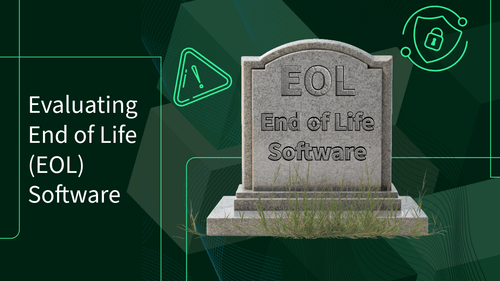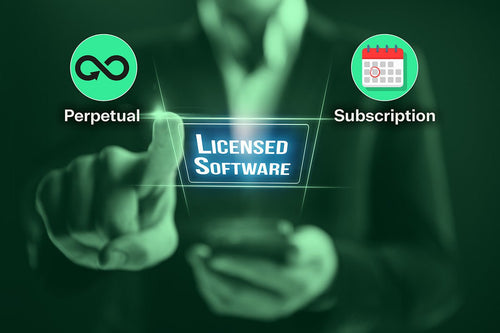When software reaches its End-of-Life, also known as End-of-Support, it may seem cheaper to keep using the outdated product, but doing so exposes your business to downtime, security breaches, compliance issues, and high costs. Here’s how to manage these risks.
Key Takeaways
- When software reaches its end of support (EOS), which is when the manufacturer stops offering updates and support, businesses become more vulnerable to security and operational risks.
- Common reasons for using EOS software include compatibility with legacy systems and cost savings, but these choices can result in compliance issues and security vulnerabilities.
- The risks of using EOS software include malware exposure, vendor incompatibility, data loss, increased downtime, and potential compromise of your Cybersecurity Insurance Policy.
- Businesses should implement best practices such as service management planning, risk assessments, phased upgrades, and using modern tools.
As IT environments change, so does the software that supports them. Eventually, every application will reach the end of its development lifecycle. For IT professionals and business leaders, understanding when software becomes outdated and how to respond can be the difference between secure operations and significant risk through planning, preparation, migration, and adopting new solutions.
What Is End-of-Life (EOL) and End-of-Support (EOS)?
End-of-support (EOS) refers to software products that are no longer supported by their developer or vendor. EOS is the correct industry term, while end-of-life is a more common phrase, but they essentially mean the same. This indicates no more updates, no new features, and most importantly, no security patches. Once software reaches EOL, it becomes frozen in time, even as cyber threats and compliance standards change. For example, support for Windows XP ended in 2014, yet millions of systems continued running it for years. Despite migration tools, support documentation, and widespread warnings, many users delayed updating due to cost, compatibility issues, or inertia.
Why Do Businesses Continue Using EOS Software?
It’s tempting to stick with old software when it still works; why change something that isn’t broken? However, there are practical reasons why many businesses keep relying on end-of-support software.
Legacy App Dependencies
Custom or industry-specific software only runs on outdated Operating System (OS) platforms. Rewriting or replacing those applications can be time-consuming and costly.
Costs
Paying for licenses, staff training, or migration experts might seem excessive; until a system failure or security breach makes those costs seem like a bargain.
Operational Disruption Concerns
Some companies delay updates because they worry that new software might disrupt essential workflows, especially in industries like manufacturing, healthcare, and other highly regulated fields.
Lack of Visibility
Many companies neglect to track software lifecycle dates, leaving older tools unchecked until they fail or become risky. While these reasons are understandable, keeping EOL software in use is rarely a wise long-term approach. Outdated systems become harder to support, more costly, and more vulnerable to modern cyber threats. That’s why proactive lifecycle management is crucial. The longer you wait, the more complex and expensive modernization will be.
What Are the Risks of Running End-of-Support Software?
EOS software leaves your business vulnerable on multiple fronts. Here’s why:
Security Risks
When software stops receiving updates, it’s like leaving the front door unlocked. Hackers know exactly where to find vulnerabilities in outdated systems, making them easy targets for malware, ransomware, and data breaches.
Compliance Issues
If your business operates in a regulated industry, such as healthcare, finance, or government, keeping systems up to date isn’t optional. Running software that’s no longer supported can cause failed audits, heavy fines, and even legal issues.
Compatibility Problems
New tools and apps often don’t integrate well with legacy systems. That can cause frustrating bottlenecks, isolated data, and a surge of support tickets from users who just want things to work.
Higher Costs and Unexpected Downtime
As older hardware and software become outdated, finding support or replacement parts becomes more difficult and costly. When something breaks, it often happens suddenly, and the downtime can be expensive.
When Is It Okay to Use End-of-Support Software?
There are rare cases where using EOS software might still make sense, but only under strict conditions:
- The system is completely disconnected from the internet (air-gapped)
- There’s no viable replacement available
- Strong security measures are in place (like endpoint protection and access controls)
- A clear plan exists for retiring the system soon
Even then, it should be the exception, not the norm. Every month spent on unsupported software increases your business risk.
Best Practices for Managing EOS Software
The good news? You can manage transitions away from EOL systems with a strategic, phased approach. Here’s how:
Take Stock of What You’re Using
Start by auditing all the software your team relies on. Flag anything that’s nearing or past its end-of-support date. Tools like Microsoft’s Assessment and Planning Toolkit or other IT asset management platforms can make this easier.
Understand What Each System Supports
Figure out what each piece of software actually does for your business. Do your teams leverage these solutions for Support Case/Ticket Management? CRM? Workplace Collaboration? Content Production? Workplace Productivity SLAs? IT Device Management? Knowing this helps you identify gaps and plan smarter replacements.
Explore Modern Alternatives
Look for updated solutions that not only replace the old ones but also add value, improve uptime, facilitate smoother integration with your current setup, and offer strong vendor support. Bonus points if the tool has a clear roadmap and an active user community.
Plan a Smooth Transition
You don’t have to replace everything all at once. Consider phased migrations using virtualization, containers, or cloud-based tools. These approaches help minimize disruption and keep operations running during the switch.
Train Your Team and Document
New tools are only effective if people know how to use them. Ensure your rollout includes hands-on training, clear documentation of use cases alongside business cases, and a solid change management plan.
Use Tech That Stays Current
Cloud platforms like Microsoft Azure or M365 offer built-in security features, automatic updates, and compliance support. They are designed to scale with your business and reduce risk over time.
Extra Tips for IT Teams
If you’re managing a more complex setup, consider layering in strategies:
Set Clear Software Lifecycle Policies
Have a plan for how software is chosen, used, supported, and eventually retired. This helps you catch outdated apps early before they turn into bigger problems.
Use Tools That Keep You in the Know
Platforms like Microsoft Intune or Azure Arc give you a clear view of what’s running across your environment, what’s up to date, what’s not, and where action is needed.
Partner with a Microsoft Licensing Expert
Working with a partner that has the right capabilities and competencies, like TrustedTech, can make a big difference. They’ll help you identify upgrade options, prevent unnecessary purchases, and unlock volume discounts when it’s time to act. The best way to handle end-of-support software is to avoid it altogether by adopting a forward-looking IT strategy and working with a knowledgeable partner.














